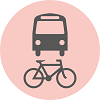Our masterplan has six key principles:
Contents
 A place of creativity and enterprise
A place of creativity and enterprise A new local residential neighbourhood
A new local residential neighbourhood A destination for fashion and culture
A destination for fashion and culture A connecting place - drawing Walcot Street into the city
A connecting place - drawing Walcot Street into the city A low traffic environment - creating positive streets and spaces
A low traffic environment - creating positive streets and spaces A climate challenge exemplar for buildings and the public realm
A climate challenge exemplar for buildings and the public realm
A place of creativity and enterprise
This principle draws on Milsom Quarter’s history as a hub of creativity and invention.
The principle aims to create a flexible range of workspace opportunities. This includes affordable, creative workspaces for start-ups and SMEs to operate in the heart of the city, ideally engaging with the fashion and homewares industries in the area. A high density of small workspace units, supported by micro-shops and elements of food and drink within the space, could help create a unique attractive character.
A new local residential neighbourhood
This principle is about increasing residential development and improving facilities and public spaces to make the Milsom Quarter a great place to live, right in the heart of the city.
Re-inhabiting the city
We propose that the Milsom Quarter will be a growing residential neighbourhood for Bath, with new development and conversions of upper floors supporting a range of local shopping and amenities at ground floor level, with a new public square.
The redevelopment of larger sites and buildings within the quarter will have the potential to enhance and improve the sustainability and resilience of this part of the city centre by providing approximately 180 new homes. While we have identified some new development sites, the vast majority of the area consists of existing buildings. Some are fully occupied and others are partially or wholly vacant. Reusing existing buildings also supports a net-zero carbon agenda.
As part of the masterplan, the project team were asked to consider the potential for bringing back into use the upper floors of buildings which are either vacant or are underutilised in their current form. This allows space to be used more effectively and provides a varied mix of uses in the area.
Broad Street
The existing southern half of Broad Street is heavily dominated by vehicles, with narrow pavements and repeated bollards to manage the impact of cars and vans. However, following the successful introduction of temporary social distancing measures in 2021 (to provide wider space for pedestrians), we aim to create an environment where people are able to take much more ownership of the space to foster a more local community character. There should be a clear route for servicing and access for businesses and homes, but the street is to be predominantly for the benefit of pedestrians.
A destination for fashion and culture
The masterplan intends to deliver a new space for the Fashion Museum and continue to support the Milsom Quarter’s status as a preeminent destination for fashion – the Fashion Museum is one of the most significant cultural projects that has been delivered in Bath.
The Fashion Museum and Collection will leave its current location in the Assembly Rooms at the end of October 2022, and will move into temporary accommodation until we can create a new space to store the collection and a new Fashion Museum in Milsom Quarter.
The enhanced Fashion Museum will play a pivotal role as an anchor institution in Milsom Quarter, enriching the economic, cultural and social life of the city. It aims to:
- Attract 250,000 visitors to the city, helping the local economy to bounce back after the pandemic
- Inspire the next generation of fashion and creative industry leaders through its partnerships with local schools and universities
- Transform people’s lives through learning, start-up and job opportunities
- Work with the local and regional community to develop a diverse and inspiring offer of exhibitions, displays and activities
- Provide a space to engage with key issues facing the fashion industry today (such as fast fashion, social impact and adverse impact on the environment) and motivate individuals and the wider industry to take action
- Help people better understand themselves and the world around them
- Increase dwell time in the city and encourage more overnight stays
- Bring Bath's identity of fashion and style right up-to-date – with cutting edge displays and relevancy at its heart
A connecting place - drawing Walcot Street into the city
This principle will help to connect the Walcot Street area to the heart of the city.
Walcot Street has steadily developed a strong reputation as a location for homewares, antiques and interiors, as well as providing workspace for a range of skilled artisan crafts. The masterplan will create an improved entrance to Walcot Street through development on the Cattlemarket site and improved public spaces. We are proposing new housing for the site alongside mixed uses at ground floor level.
We also propose to improve the east-to-west connections within Milsom Quarter, better linking Milsom Street, Broad Street and Walcot Street, and reconnecting Walcot Street with the rest of the city.
A low traffic environment - creating positive streets and spaces
This principle will give priority to people over vehicles to create great streets and spaces whilst ensuring Milsom Quarter is accessible to everyone.
Transport and movement
The access and movement strategy for Milsom Quarter has been produced to support and inform the development of the masterplan. The key aims of this strategy are to:
- Increase sustainable accessibility and permeability
- Minimise the impact of motor vehicles
- Improve the quality of the environment
- Provide space for people and businesses to thrive
- Enhance the economic success of the area
Public realm and movement
We have designed improvements to the public realm in response to alternations in highway management and traffic flow in Milsom Quarter.
The public realm strategy follows the movement strategy in this urban design framework chapter. The key principles of the strategy are increasing greening, prioritising pedestrians and enhancing east to west connections, with the ambition of reclaiming the streets for people and businesses to thrive.
A climate challenge exemplar for buildings and the public realm
The masterplan strategy is to invest in the buildings and the public spaces to be more sustainable and more resilient to the effects of climate change.
Energy strategy
Evidence shows that many of the existing buildings in the Milsom Quarter are unimproved, poorly-insulated and do not perform well in terms of energy efficiency. As a significant land owner, we plan to invest in the energy performance of our buildings. We have also committed to achieve Carbon Neutrality by 2030.
Our sustainability priorities include:
- Undertaking energy efficiency improvements to the majority of existing buildings
- Ensuring all new buildings are zero carbon
- Encouraging the use of active travel methods such as public transport, walking and cycling to reduce transport emissions
- Rapidly increasing local renewable energy generation
